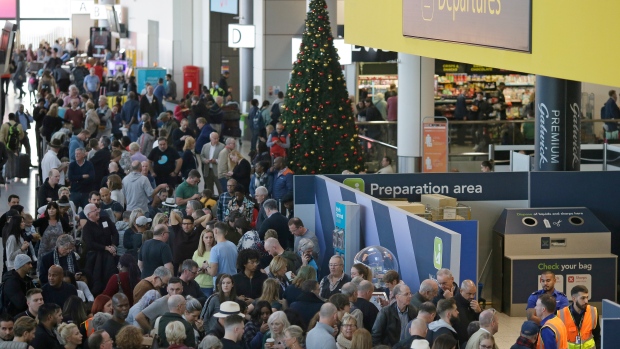Dec 20, 2018
London's Gatwick airport reopens with mammoth backlog as illegal drones disappear
, Bloomberg News

London’s Gatwick airport reopened for flights Friday while cautioning that it’s still on the hunt for illegal drones that buzzed the hub for almost 24 hours, disrupting travel for more than 120,000 people.
With many planes and staff still out of position, Gatwick cautioned that it will struggle to operate a normal timetable, let alone clear the backlog of passengers who found themselves grounded by the mystery incursions. It added that there’s no guarantee the devices are gone.
“Obviously there is a possibility that the drones could return,” a Gatwick spokeswoman said by phone while adding that management are “suitably content in working with the police and other experts to reopen.” People should check with their airline before traveling to the terminal, the airport advised.
Sussex police, who have been dealing with the incident along with specialists from Britain’s armed forces, said there were almost 50 drone sightings at the airport between 9:07 p.m. Wednesday and 4:25 p.m. on Thursday, though some may have been duplicates. A statement on the force’s website said that “as yet, the drone has not been identified,” while the U.K. government said that a variety of steps have been taken to make the airport safe.
Gatwick reopened at 6:00 a.m. local time (1:00 a.m. ET) and about two hours later online information boards showed that just three flights had landed, two from Dublin and one from Bordeaux, while 25 had departed, all of them short-haul services.
The airport is Britain’s second busiest and the biggest hub for EasyJet Plc, as well as being a focus for long-haul leisure flights a British Airways. It also counts Virgin Atlantic Airways Ltd., Norwegian Air Shuttle ASA, Thomas Cook and TUI AG as major operators. Ryanair Holdings Plc, which has limited presence at Gatwick, switched Friday flights to its main Stansted base.
It’s not clear how long it will take to restore order at Gatwick after the worst disruption at a London airport since blizzards closed Heathrow in 2013. The hub has only one runway, which is already the world’s busiest, offering little scope to cram in more flights even if the drones stay away.
U.K. authorities portrayed the intrusion as deliberate, with Gatwick Chief Executive Officer Stewart Wingate saying it had been “highly targeted” and designed to deliver maximum disruption in the days before Christmas. Police said the actions were clearly intentional, though most likely not terror related.
The pair of drones got the better of a multi-fronted operation for the best part of two days. A daylight search backed by helicopters failed to locate the devices or their operator, prompting the Ministry of Defence to send in army personnel equipped with specialist gear as night fell Thursday.
In a bid to ease the backlog of flights, the Department for Transport temporarily lifted a ban on night operations at other U.K. airports.
Unmanned aerial vehicles and laser pointers are becoming an increasing threat for aircraft, prompting regulators to come up with new rules against operating the devices near airfields.
Dubai International Airport shut down temporarily in 2016 after suspected drone activity, while airspace around Wellington, New Zealand, was closed for 30 minutes this year when a craft was spotted flying close to the runway. And Grupo Aeromexico SAB last week said was investigating whether a drone collided with a Boeing Co. 737 aircraft as the plane approached Tijuana, Mexico. The jet sustained damage to its nose but landed safely.
While governments bar drones from paths reserved for airliners, with Britain outlawing flights above 400 feet or within one kilometre (0.6 miles) of an airport boundary, the millions of small consumer devices that have been purchased around the world can’t be tracked on radar.
That makes it difficult to enforce the rules. In addition, many users don’t know the restrictions, or don’t follow them, despite the threat of a five-year jail term for perpetrators in the U.K.
Transport Secretary Chris Grayling told the BBC on Friday that a variety of anti-drone protection technologies have been deployed at Gatwick, while adding that authorities still have no idea who was behind the raids.
“We’ve had to assemble a variety of different measures around that airport to make sure it’s safe,” he said. “This is an unprecedented event. There’s not been anything like this anywhere in the world.”


